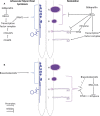The Role of Gibberellins and Brassinosteroids in Nodulation and Arbuscular Mycorrhizal Associations
- PMID: 30930916
- PMCID: PMC6429038
- DOI: 10.3389/fpls.2019.00269
The Role of Gibberellins and Brassinosteroids in Nodulation and Arbuscular Mycorrhizal Associations
Abstract
Plant hormones play key roles in nodulation and arbuscular mycorrhizal (AM) associations. These two agriculturally and ecologically important symbioses enable plants to gain access to nutrients, in particular, nitrogen in the case of nodulation and phosphorous in the case of AM. Work over the past few decades has revealed how symbioses with nitrogen-fixing rhizobia, restricted almost exclusively to legumes, evolved in part from ancient AM symbioses formed by more than 80% of land plants. Although overlapping, these symbiotic programs also have important differences, including the de novo development of a new organ found only in nodulation. One emerging area of research is the role of two plant hormone groups, the gibberellins (GAs) and brassinosteroids (BRs), in the development and maintenance of these symbioses. In this review, we compare and contrast the roles of these hormones in the two symbioses, including potential interactions with other hormones. This not only focuses on legumes, most of which can host both symbionts, but also examines the role of these in AM development in non-legumes. GA acts by suppressing DELLA, and this regulatory module acts to negatively influence both rhizobial and mycorrhizal infection but appears to promote nodule organogenesis. While an overall positive role for BRs in nodulation and AM has been suggested by studies using mutants disrupted in BR biosynthesis or response, application studies indicate that BR may play a more complex role in nodulation. Given the nature of these symbioses, with events regulated both spatially and temporally, future studies should examine in more detail how GAs and BRs may influence precise events during these symbioses, including interactions with other hormone groups.
Keywords: DELLA; arbuscular mycorrhizae; brassinosteroid; gibberellin; nodulation; plant hormone; symbioses.
Figures

References
-
- Baum C., El-Tohamy W., Gruda N. (2015). Increasing the productivity and product quality of vegetable crops using arbuscular mycorrhizal fungi: a review. Sci. Hortic. 187, 131–141. 10.1016/j.scienta.2015.03.002 - DOI
Publication types
LinkOut - more resources
Full Text Sources
Other Literature Sources
Miscellaneous

